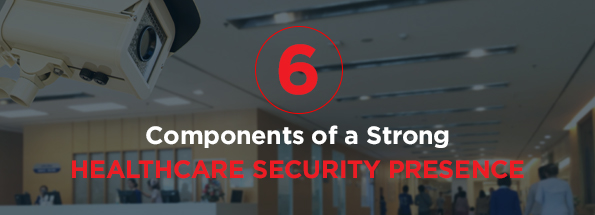6 Components of a Strong Healthcare Security Presence

A strong healthcare security program begins with a strong presence. This presence should be both seen and felt, cultivating a multi-dimensional experience of safety. Even in moments where security is subtle, like in the case of consistent uniforms, the elements of security presence can make all the difference in a patient’s experience.
Here are the key components to a strong presence:
1. Tangible Presence
Being seen is part of a strong program. Uniformed security guards, a prominent desk, security cameras, and signs are all visible elements of a security program. When customers consistently see components of the security program wherever they go, this presence creates a sense of being held and protected by the program.
2. Intangible Presence
Managing protocols with consistency goes a long way to creating a security presence. When each employee (beyond just security staff) is following the same operations or protocols, other staff and patients see that there is a structure within the organization. Structure and safety go hand in hand as consistency conveys stability. Customers know they can count on a strong operation. They are seeing that standards can be upheld and the crossover assumption is that they can count on receiving the same level of care they are seeing elsewhere. Consistency is a big part of creating an intangible security presence.
3. Training
In order to establish consistency in a visible presence as well as in the intangible presence elements, cross training must take place between departments. The security team needs to be trained based on a strong security strategy. Security personnel also need to understand the facility or organizational brand so they can operate consistently with the rest of the organization. Likewise, the entire staff needs to understand security expectations so the whole team can collectively be responsive and consistent. In order to be thorough, everyone needs to be trained.
4. Access Control
Entry and exit is another key component to a strong security presence. If there is no control over access points, there is no control overall. Unrestricted access to a facility could mean great potential risk. In today’s climate of increasing aggression, violence, and crime, the vulnerable setting of a healthcare facility requires staff and patients feel safe in order to do their best work (or healing). The bottom line of a healthcare facility can also be at risk if equipment, supplies, or drugs are too easily accessible.
5. Physical Barriers
The simple concept of a barrier can be enough to deter a security risk or breach. If there is a lock, a wall, a door, or even a curtain, the sense of safety and security increases dramatically. When a barrier can contain an incident, the barrier can both create this sense and contain any risk that arises.
6. Background Screening
Human resources designs, controls, supports, or maintains every aspect of a healthcare facility, including the healthcare security program. Choosing selectively whom will fill which role is a key part of running a successful program. Screening each person carefully for strengths, weaknesses, and possible risk is critical. Knowledge is power. Combined with monitoring data and trend tracking, background screening can be a powerful tool to manage staff placements and, ultimately, the facility environment.
To learn more about the keys to a strong healthcare security program, read our whitepaper, “3 Key Components of an Effective Healthcare Security Program,” or contact a Lowers & Associates risk management consultant today.